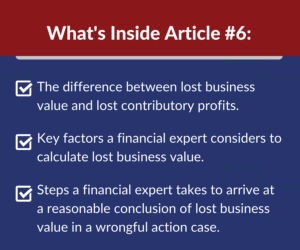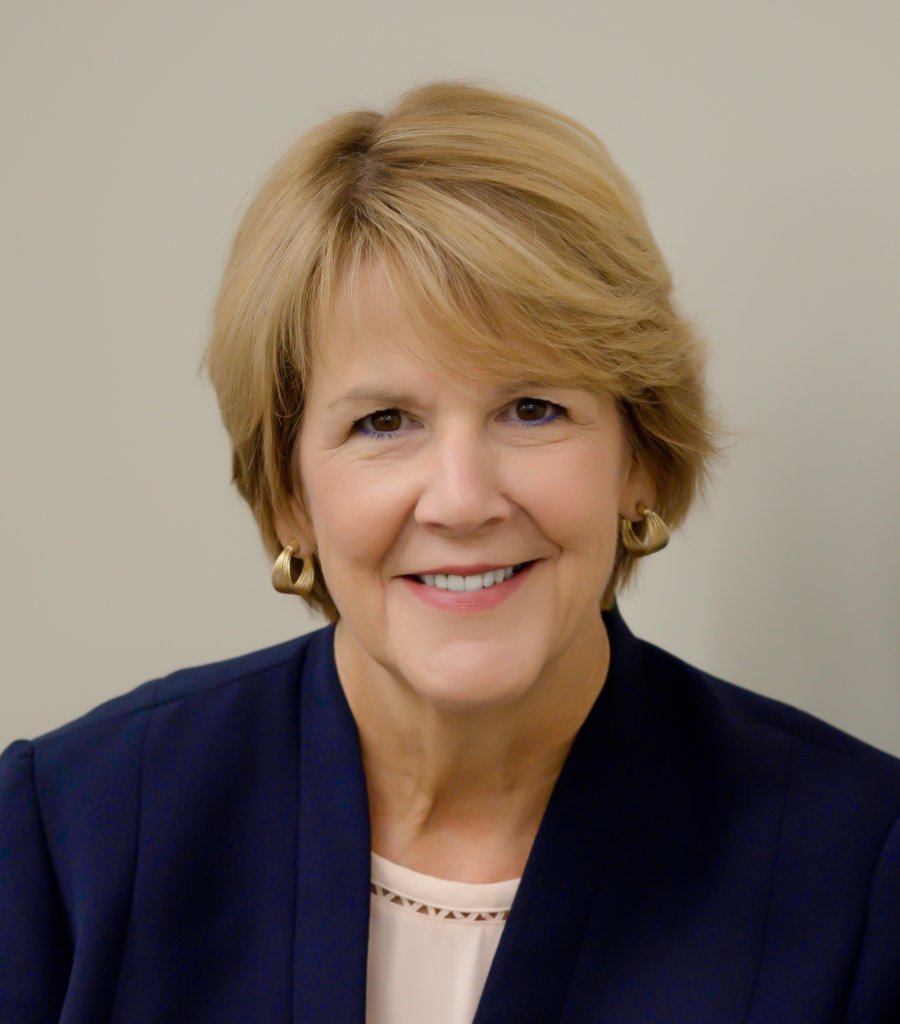
Article 6: Determining Damages—Lost Business Value
Welcome back to our series on working with a financial expert in business litigation. If you missed the last article on calculating lost contributory profits, which explored what an expert does when a business, product line or business segment has been damaged, but the business as an entity continues, you can read it here.
Alternatively, in this article we are looking at the scenario whereby the alleged damaging event has resulted in the demise of the business—whether an immediate destruction or slow death of the business.
Where an immediate destruction of the business occurs, diminution of business value generally is indicated as the most appropriate measure of damages to be used by a damages expert. Alternatively, the slow death of a business might use a combination of the two approaches—lost contributory profits (as was covered in the last article) and diminution of value.
Here we will look more closely at how the damages expert measures the diminution of business value by determining the fair market value of the business just prior to the alleged wrongful event using the income approach.

Calculating Lost Business Value
Let’s assume the defendant breached a seven-year contract to purchase raw material from the plaintiff. The plaintiff was highly dependent on the defendant’s purchases, having added specialized, expensive equipment specifically to service this customer, and the remaining customers’ revenues were not sufficient to cover the business’s fixed costs. As a result, the supplier went out of business. In order to make the owners of the supplying business whole, one could argue they need to be compensated for the fair market value of their entire business that is no longer in existence, caused by the alleged wrongful act of breaching the contract. To do this, the business valuation expert models what would have likely happened to the business had it continued uninterrupted in order to determine the “would be” value of the business, which has now been lost.
First, it’s important to look at the definition of business value: the value of any operating business is equal to the present value of its expected future economic benefit stream.
Another way to say this is that the value of any operating business is equal to the future cash flows the business is expected to generate, discounted to present value using a discount rate that reflects the risk of those cash flows actually occurring. So the business valuation expert’s task is to project the expected future cash flows for the business (assuming the alleged wrongful act did not occur) and determine the risks associated with those cash flows occurring as projected, which will be reflected in the discount rate used to calculate the present value. How does the expert learn what is expected in the future of the business? The expert can consider:
- Management’s business plans, projections, or forecasts prepared prior to the alleged wrongful actions. These can be key because they are free of litigation motives.
- The business’s historical performance before the damaging event.
- Management’s input regarding future expectations.
- Industry and benchmarking data to compare what management is saying.
If the expert is relying on the business owners’ representations it is critical that consideration of all factors—both internal and external to the business—are considered in order to establish ‘reasonable certainty.’ Does what the expert is being told make sense?
The general steps taken by the expert to arrive at a reasonable conclusion of lost business value include the following:
- 1. Gathering and analyzing information about the business’s quantitative history including five years of year-end financial statements and tax returns for the business.
- 2. Gathering information about the business’s qualitative characteristics that can impact value. Some of the key factors needing consideration include the company’s:
- a. Customers
- b. Vendors
- c. Employees
- d. Competition
- e. Reputation
- f. Contracts
- g. Years in Business
- h. Management Depth
- 3. Developing an understanding of what the future business plan was for the company prior to the alleged wrongful activity and developing assumptions for modeling cash flow projections—where was the business planning to be in the current year, next year, and the year after? The expert tests the reasonableness of this information against past performance, the industry outlook, and other available resources. Adequate logic and/or support must be provided for the assumptions that the projections are based on.
- 4. Modeling explicit (near-term and detailed) and terminal (long-term and more general) projections for the company’s future. Business valuation assumes that all businesses are ongoing, so any business plan and related projections continue on into perpetuity. This means that, unlike the situation of calculating lost contributory profits, the period of time for projecting future expected cash flows is divided into two components—the explicit period of projections and the continuing value, or terminal period. With exceptions, three to five years is the standard length of the explicit, more detailed period where changes in the company’s business plan are modeled in detail (revenues, expenses, capital reinvestment). Since making reliable forecasts of expected cash flows after the explicit period is difficult, the expert will usually assume that cash flows stabilize and can be capitalized into perpetuity to determine the terminal period’s cash flows. This represents an average of future growth rates, not one expected to occur every year into perpetuity, and typically hovers around long-term, inflationary growth levels.
- 5. Next the expert needs to determine the discount rate used to calculate the present value of these future cash flows. This discount rate is the combined weighted average cost of the two sources of capital to the damaged business: the cost of debt and the cost of equity–referred to as the weighted average cost of capital or WACC.
- The cost of debt is usually defined as the subject company’s borrowing rate, net of the tax benefit associated with the deductibility of interest expense. The cost of equity is equivalent to the rate of return a hypothetical equity investor would require to invest in a company similar to the subject company. Equity investors determine their required rate of return for a specific investment by considering rates of return on other comparable equity investments. The cost of equity is determined by researching comparable alternative investments considering the subject company’s size, industry, and company specific risk factors. This requires using data gathered from publicly traded companies and analyzing the subject company’s strengths or weaknesses of various qualitative factors.
- These two sources of capital (debt and equity) are then weighted based on the mix of debt and equity in the company’s actual capital structure to arrive at the weighted average cost of capital. Each year’s future projected flows are then discounted back to present value (or date of damages) using the weighted average cost of capital.
Applying Appropriate Premiums and Discounts
- 6. Finally, the expert needs to consider appropriate discounts for lack of marketability that apply to all closely held businesses since the discount rate is based on publicly traded company data. Therefore, when the subject company’s cash flows are discounted by a discount rate generated from publicly traded data, the resulting level of value is “as though publicly traded” (marketable in three days and minority equity interest). These discounts (and other possible premiums) allow the expert to adjust the value conclusion to the level matching the specific assignment–typically ‘closely held’ (sometimes called illiquid), and ‘control’ if the expert is valuing the loss of an entire business.
- 7. Ultimately, this concludes with the fair market value of a 100% equity interest in the business (based on a control, illiquid basis) “but for” the alleged wrongful activity or action. Since the business ended as a result of the alleged event(s), this loss of business value represents the damages to the plaintiff.
Conclusion
In summary, if the alleged wrongful action caused the business to end, the financial/damages expert will likely determine the fair market value of the business, assuming the alleged wrongful action had not occurred. This is done by:
- 1) Analyzing the historical performance of the company and understanding the qualitative business factors.
- 2) Modeling the future business plan for the company resulting in future cash flow projections.
- 3) Developing a discount rate specific to the business for calculating the present value of such future cash flows.
- 4) Determining and applying appropriate premiums and discounts to arrive at the fair market value of the business just prior to the wrongful action.
Each case is unique and the expert needs to gather the facts (internal and external to the business), analyze history and gain a full understanding of the business—both the qualitative and quantitative factors–to develop a reasonable valuation model that is objective and supportable.
Coming up Next Time
Next time, we will do a deeper dive into the deposition—how to prepare your financial expert and also key questions to ask when deposing an opposing expert witness and tips on how to deal with “non-answers.”
We’re Here to Help
Hiring the right financial expert can have a significant impact on your case. Based on our firm’s 45+ years of experience focused entirely on determining damages and valuing businesses, we can provide insight, experiences, and ideas for ways to approach the financial portion of your litigation project that you may not have encountered yet.
Stay tuned to your inbox and follow Capital Valuation Group on LinkedIn as we share more from this series on successfully working with financial experts through each phase of the litigation process. If you have a particular situation you would like to discuss, give us a call. We are happy to have a complimentary initial discussion.
Would you or other people in your firm find value in this series? Please share or they can subscribe to our email list here.

Cathy Durham is a principal of Capital Valuation Group, Inc., headquartered in Madison, WI. Capital Valuation Group has been helping business owners across the country understand, increase and unlock the value of their businesses for over 45 years through keynote speaking, valuation analysis, determining damages and providing expert witness testimony. Cathy welcomes conference and event speaking inquiries and can be reached at cdurham@capvalgroup.com. Phone 608-257-2757
